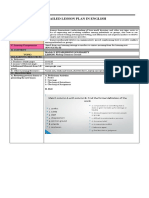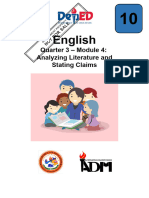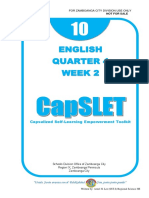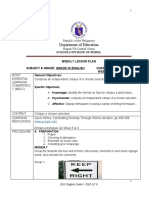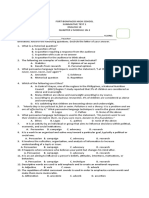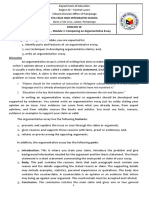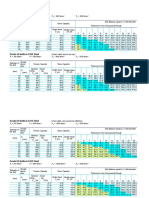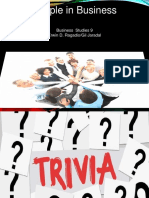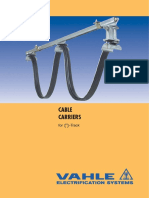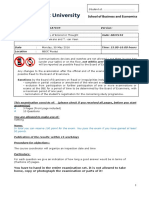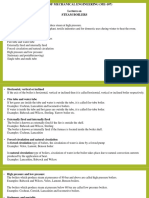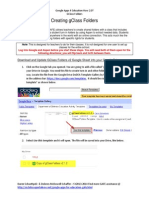GRADE 10-LESSON 1 Only Jayson
Uploaded by
jolina enardecidoGRADE 10-LESSON 1 Only Jayson
Uploaded by
jolina enardecidoJAYSON DIGAMON
What I know
Pre-Test
As part of your initial activities, you need to answer this pre-assessment to
check your prior knowledge on the topics of this module. Try to assess yourself
about your previous knowledge on persuasive text and assertions.
Directions: Read each question below and choose the letter of the correct answer.
1. What is the purpose of persuasive writing?
A. to entertain a reader
B. to convince a reader
C. to inform the reader
D. to describe a series of events
2. Which is not a characteristic of a good persuasive writing piece?
A. The writer provides strong arguments as support.
B. The writer provides information based from opinions only.
C. The writer entertains the reader with engaging dialogue between
characters.
D. The writer uses illustrations, photographs, and diagrams to convince the
reader.
3. What is a rhetorical question?
A. a statement of fact
B. a question that is part of a quotation
C. a question requiring response from the audience
D. a question designed to make the audience think
4. How do the authors share their opinion about an issue through persuasive writing?
A. share their personal opinion
B. support their opinion through evidences
C. make up fictional information to trick the reader
D. share the opinions of others that are similar to theirs
5. Which a not an example of a persuasive text?
A. a television advertisement
B. a political speech
C. a political cartoon
D. a photograph of political figure
6. Which is not a feature of persuasive text?
A. fictional ideas
B. supporting ideas and arguments
C. clear organization or structure
D. thesis statement
7. What is the primary purpose of a document that is written to convince readers to
change their opinions?
A. to answer question
B. to build goodwill
C. to persuade
iv
D. to inform
8. Which persuasive technique use words like we, you, our and us to make the
audience think the speaker is talking to them?
A. repetition
B. alliteration
C. exaggeration
D. personal pronouns
9. What are the roles of an author of a persuasive text?
A. The author is telling a story.
B. The author is informing the reader.
C. The author is convincing the reader to agree with him/her.
D. all of the above
10. How should an author of a persuasive text back up his/her claim or argument?
A. support
B. claim
C. text
D. argument
11. How does persuasive text begin?
A. with a clear statement or thesis about the purpose of the text.
B. with the reasons about the claim
C. with the summary of the claim
D. with a question
12. What is the purpose of the persuasive text below?
“Please support our children players by buying these raffle tickets.”
A. create interest
B. make a change
C. prove something wrong
D. support a cause.
13. Which of the following is an example of assertion?
A. “I believe that fate cannot be altered because it is fixed.”
B. “Fate is an outcome of one’s actions.”
C. “I think that anyone can change his own fate.”
D. “For me fate is only what a fortune teller says.”
14. Which of the following do not serve as a guide in writing an assertion?
A. being artistic
B. being knowledgeable
C. backing up with evidence
D. being clear and concise
15. Which of the following best defines an assertion?
A. It is a statement used to make a declaration or to make strong belief on a
particular topic.
B. It refers to the view somebody takes about an issue, especially when it is
based solely on personal judgment.
C. It is known to be consistent with objective reality and can be proven true.
D. It is liking one idea over other ideas
v
Lesson
1 Persuasive Text
What I Need to Know
Welcome to your first lesson of this school year! To start with, let us try to find out
the learning competencies in which you are going to master at the end of this lesson.
Skills and Competencies/Objectives:
At the end of this lesson, you are expected to:
define persuasive text; and
identify the purpose of persuasive texts.
Materials Needed:
Electronic gadgets (cell phones/computers/LED TV)
Internet access
Activity notebook
What I Know
Task 1: I Believe
Directions: Think of something that you believe in and explain why. It could be
your belief about life, love, education, or religion. State reasons to support your belief in
three to five sentences.
•I believe that educationstressful right now, specially this
pandemic situations. Hope that all of us will succeed in study
despite of stress situation.
6
What’s In
Task 2: I Think
Directions: You have successfully shared your belief about a
certain topic in Task 1. This time you are going to write a sentence about your idea on
persuasive texts. Write your answer on your activity notebook.
•A persuasive speech is given for the purpose of persuading the audience
to feel a certain way, to take a certain action, or to support a specific view or
cause. … Examples of Persuasive Speech: 1. A teenager attempting to convince
her parents that she needs to be able to stay out until 11pm instead of 10pm
What’s New
Before you start the lesson on features of persuasive text, you need to answer
the following activity below.
Task 3: True of False
Directions: Identify each statement as true or false. Write T on the blank if the
statement is true and F if it’s not.
___T___1. The purpose of persuasive writing is to tell a story.
___T___2. It is important for students to write for authentic purposes and real
audiences.
___F___3. Using graphic organizers is an effective way to learn about
persuasive writing.
7
What’s More
Task 4 : The Write Time
Directions: Answer the questions below on your activity notebook.
1. What is a persuasive text?
•A persuasive text is any text where the main purpose is to present a point
of view and seeks to persuade a reader. A persuasive text can be an argument,
exposition, discussion, review or even an advertisement.
2. Choose at least three uses of persuasive texts and write a persuasive
statement to each of them.
• The persuasive purpose is used to convince, or persuade, the reader that
the opinion, or assertion, or claim, of the writer is correct or valid. Persuasion is
more selfish than argument (debate).
…
Main Characteristics:
•Persuasive claim.
•Support points.
•General warrant.
Use of appeals: emotional, personal, logical.
What I Have Learned
Task 5: Which is Which?
8
Directions: Analyse each persuasive statement below and identify its purpose.
Choose your answer from the box and write it on the space provided before each
number.
Create interest Support a cause Stir up sympathy
Urge people to action Get people to agree with you Prove something wrong
Create interest 1. Please join the run for a cause so we can help the
cancer patients
Urge people to action 2. If you don’t adopt the dog, it might be killed on the street.
Get people to agree with you 3. Don’t throw your garbage anywhere.
Stir up sympathy 4. Choosing friends wisely makes you happy.
Prove something wrong 5. I’m sure that you won’t disagree if I would say that
cats are better pets than dogs.
What I Can Do
Task 6: Persuasion Time
Directions: What do you think about this idea? Write a persuasive text on your
activity notebook. Refer to the rubrics for the scoring.
Junk food – Should it be banned at school?
• My idea is we or I need to be responsible for my actions of
how to care our selves, and most of all we need to be reliable to
everyone around us.We need to convince anyone to take good care
to our own actions..
Persuasive Text Rubric
6 5 4 3 2 1
Takes a clear Takes a clear Takes a clear Takes a Takes a Attempts to
position and position and position and position and position, but the take a
supports it supports it supports it provides essay is position
consistently with relevant with some uneven underdeveloped (addresses
with well- reasons or relevant support; may topic), but the
chosen examples reasons or lack position is
reasons or through much examples; development very unclear
9
examples; of the essay. there is some in parts or be OR takes a
may use a development repetitive, or position, but
persuasive of the essay. the essay is provides
strategy to no more than minimal or no
convey an a well-written support; may
argument. beginning. only
paraphrase
the prompt.
The essay is The essay well The essay s The essay is The essay is The essay
focused and organized but well organized generally disorganized or exhibits little
well may lack but may lack organized but unfocused in or no
organized, some some has few or no much or of the apparent
with effective transitions. transitions. transitions essay R is organization.
use of among clear, but too
transitions. sections. brief.
Consistently y Exhibits some Exhibits some Most Sentences lack Sentences
exhibits variety variety in variety in sentences are formal run-on and
in sentence sentence sentence well structure; word appear
structure and structure and structure and constructed choice may incomplete or
word choice. uses the right uses the right but have a often be rambling;
word choice; word choice; similar inaccurate. word choice
occasionally, occasionally, structure; word may be
words may be words may be choice lacks inaccurate in
used used variety or flair. much or the
inaccurately. inaccurately. entire essay.
Errors in Errors in Errors in More frequent Errors in Errors in
grammar, grammar, grammar, errors in grammar, grammar,
spelling, and spelling, and spelling, and grammar, spelling, and spelling, and
punctuation punctuation do punctuation do spelling, and punctuation punctuation
are few and not interfere not interfere punctuation, interfere with prevent the
do not with with but they do not understanding reader from
interfere with understanding. understanding interfere with in much of the fully
understanding . understanding. essay. understanding
. the essay.
Comments/
Suggestions
Source: https://rb.gy/uwqn8g
Assessment
Task 7: I Learned
Directions: Read the each question carefully and choose the letter of the correct
answer in your activity notebook.
1. What is the main intention of the author when writing a persuasive paper?
10
A. to convince the reader to write their counter-argument
B. to raise awareness about issues in the world
C. to convince the reader to agree with the author about an issue through the
use of facts
D. to encourage the reader to have the same opinion with the author about an
issue through fictional facts
2. Which of the following sentences best explains persuasive writing?
A. It is a non-fiction writing used to convince the reader to agree with the
author about an issue.
B. It is a fictional writing used to convince the reader to agree with the author
about an issue or topic.
C. It is used strictly for commercial scripts to convince the audience to buy a
company’s product.
D. Persuasive writing is used to inform the reader about an issue and will
provide no facts favoring either side.
3. How does the author share his/her opinion about an issue through persuasive
writing?
A. Share his/her personal opinion.
B. Support his/her opinion through the uses.
C. Create fictional information to trick the reader.
D. Share the opinions of others that are similar to his/hers.
4. The following are things you need to remember in persuasive writing EXCEPT:
A. plan your writing before you begin
B. check your spelling and punctuation
C. the length of your persuasive essay
D. check and edit your writing when you are finished
5. The primary purpose of a document that is written to convince readers to change
their opinions is to
A. answer a question
B. build goodwill
C. persuade
D. inform
Additional Activity
Task 8: I Write
Directions: Complete the sentence below in your activity notebook.
I learned that a persuasive text is
•The definition of persuasive is someone or something with the
power to convince. An example of persuasive is an argument that changes
someone’s mind. Adjective.
Congratulations! Now you are ready for Lesson 2.
11
You might also like
- PPT-G10-BARTOLOME - M3.2 Writing Techniques in Informative100% (2)PPT-G10-BARTOLOME - M3.2 Writing Techniques in Informative45 pages
- g10 English Lesson Exemplar 4th QuarterNo ratings yetg10 English Lesson Exemplar 4th Quarter63 pages
- Discoverie of Witchcraft by Reginald Scot, 15840% (1)Discoverie of Witchcraft by Reginald Scot, 15841 page
- Recognizing The Gift of Nature: Module 3: Lesson 1No ratings yetRecognizing The Gift of Nature: Module 3: Lesson 158 pages
- Learning Activity Sheet in English 10: Worksheet No.3, Quarter 2100% (2)Learning Activity Sheet in English 10: Worksheet No.3, Quarter 25 pages
- English10 q3 Mod4 - Analyzingliteratureand-Statingclaims v2No ratings yetEnglish10 q3 Mod4 - Analyzingliteratureand-Statingclaims v244 pages
- Raise Question To Clarify Issues Covered in The Material ViewedNo ratings yetRaise Question To Clarify Issues Covered in The Material Viewed7 pages
- I. Objectives: World Literature. Pp. 317-319No ratings yetI. Objectives: World Literature. Pp. 317-3199 pages
- Nagbalaye High School: Directions: Listen To The Song "WHAT A WONDERFUL WORLD" by LOUIS ARMSTRONGNo ratings yetNagbalaye High School: Directions: Listen To The Song "WHAT A WONDERFUL WORLD" by LOUIS ARMSTRONG4 pages
- Region Vii - Central Visayas Division of Cebu ProvinceNo ratings yetRegion Vii - Central Visayas Division of Cebu Province12 pages
- Feminism: MELC: Critique A Literary Selection Based On A Feminist ApproachNo ratings yetFeminism: MELC: Critique A Literary Selection Based On A Feminist Approach16 pages
- English 10: Achieving The Writer'S PurposeNo ratings yetEnglish 10: Achieving The Writer'S Purpose18 pages
- English Quarter 4 Week 2: Capsulized Self-Learning Empowerment Toolkit0% (1)English Quarter 4 Week 2: Capsulized Self-Learning Empowerment Toolkit6 pages
- Drills On The Usage of Textual Aids: Self-Learning Kit100% (1)Drills On The Usage of Textual Aids: Self-Learning Kit16 pages
- Demonstrative Interrogative Relative and Indefinite100% (1)Demonstrative Interrogative Relative and Indefinite14 pages
- English 10 - 4th Quarter Lesson 7 and 8No ratings yetEnglish 10 - 4th Quarter Lesson 7 and 834 pages
- English 10 - Unit 3 - Lesson 3 - Writing A Toast SpeechNo ratings yetEnglish 10 - Unit 3 - Lesson 3 - Writing A Toast Speech26 pages
- Determining Unsupported Generalization and Exaggeration80% (10)Determining Unsupported Generalization and Exaggeration13 pages
- Parallel Assessment in English 10 Quarter 2 Module 1No ratings yetParallel Assessment in English 10 Quarter 2 Module 12 pages
- Reflexive Pronouns - : Module 1 For ENGLISH 10No ratings yetReflexive Pronouns - : Module 1 For ENGLISH 105 pages
- Opinions and Commonplace Assertions VS. FactsNo ratings yetOpinions and Commonplace Assertions VS. Facts6 pages
- English: Quarter 3 Module 2b: Using A Variety of Persuasive and Argumentative Writing Techniques50% (2)English: Quarter 3 Module 2b: Using A Variety of Persuasive and Argumentative Writing Techniques20 pages
- English 10 - Q2 - Module 4 - Observe The Language of Research Campaigns and AdvocaciesNo ratings yetEnglish 10 - Q2 - Module 4 - Observe The Language of Research Campaigns and Advocacies15 pages
- Most Essential Learning Competencies in English (Equal Per Quarter) GRADE 1-10No ratings yetMost Essential Learning Competencies in English (Equal Per Quarter) GRADE 1-1011 pages
- High-Tech Tools For Teaching Physics: The Physics Education Technology ProjectNo ratings yetHigh-Tech Tools For Teaching Physics: The Physics Education Technology Project30 pages
- NASA's Space Science and Applications ProgramNo ratings yetNASA's Space Science and Applications Program208 pages
- Grade 4.6 Bolts in S275 Steel: S - 2 T - 2 BB - 2 Bs - 2No ratings yetGrade 4.6 Bolts in S275 Steel: S - 2 T - 2 BB - 2 Bs - 23 pages
- People in Business: Business Studies 9 Erwin D. Ragadio/Gil JaradalNo ratings yetPeople in Business: Business Studies 9 Erwin D. Ragadio/Gil Jaradal36 pages
- Computational Investigation On Ventilated Supercavitating Flows and Its Hydrodynamic Characteristics Around A High-Speed Underwater VehicleNo ratings yetComputational Investigation On Ventilated Supercavitating Flows and Its Hydrodynamic Characteristics Around A High-Speed Underwater Vehicle19 pages
- Simulatiing Porosity in Ductile Iron - Etip17No ratings yetSimulatiing Porosity in Ductile Iron - Etip172 pages
- Xcell Ammonia (NH) Sensor: Technical Data SheetNo ratings yetXcell Ammonia (NH) Sensor: Technical Data Sheet2 pages
- Manufacturing Considerations in Liquids: - Water Condensate ...................... - Steam .................No ratings yetManufacturing Considerations in Liquids: - Water Condensate ...................... - Steam .................12 pages




